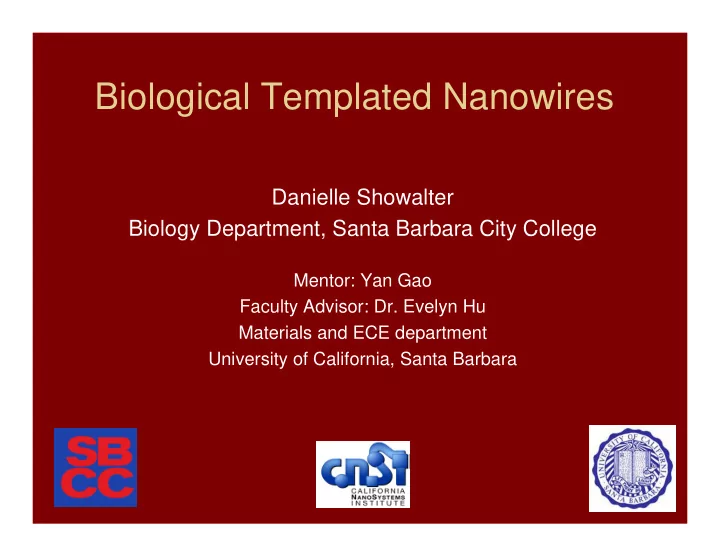

Biological Templated Nanowires Danielle Showalter Biology Department, Santa Barbara City College Mentor: Yan Gao Faculty Advisor: Dr. Evelyn Hu Materials and ECE department University of California, Santa Barbara
Motivation for bio-templated nanowires • The use of biological materials as templates for nanowires • Creation of wires that are very small (<100nm) • Placement of assembled nanowires • Cost effective • Potential to integrate with current fabrication technology Potential for bio-templated nanowires • Constructed wires will replace current larger scale wires found in circuit boards • Smaller wires will enable the device to function at a much faster rate Summer 2005 D. Showalter
Research Procedures Assisting: 1. Synthesis of the nanowires using biological materials 2. Locating wires using Scanning Electron Microscopy (SEM) and making contacts on the bio-templated nanowires using E-Beam Writing (EBW) technique My Project: -Using Atomic Force Microscopy (AFM) to locate and characterize wires both before and after the contacts are made. Before contact: -looking at the quality of the wires by checking the coverage of the Au particles After contact: -check the morphology of the wires, as they may change during contact procedures Summer 2005 D. Showalter
Procedures 1. Prepare SiO2/Si substrates 2. Pre-pattern the Ti/Au contacts Ti/Au SiO2 Si 4. Locate the nanowires via 3. Deposit the bio-templated SEM and deposit the contact nanowires solution on these electrodes using E-Beam substrates Writing (EBW) technique Contact electrodes Bio-templated nanowires Summer 2005 D. Showalter
Atomic Force Microscopy What is AFM ? A scanning probe microscope, which measures the attractive and repulsive forces between a tip and the sample *http://www.mrl.ucsb.edu/mrl/centralfacilities/m icroscopy/index.html How does AFM work? a sharp tip is scanning on sample surface in a controlled contact or tapping mode and the signals carrying surface information are collected, processed and then plotted on a computer screen. *http://www.che.utoledo.edu/nadarajah/webpa ges/whatsafm.html Summer 2005 D. Showalter
Initial Results AFM of nanowires before and after contact (Ti/Au as contact metal) Phage-templated wire Ti/Au metal contact 1µm After 1µm Before Summer 2005 D. Showalter
Electrical result of Au Phage-templated nanowire SEM of contacted Au phage-templated nanowire I-V of Phage-templated Au nanowire 1.5 sample# D12_23 1.0 D12_23 0.5 I (mA) 0.0 -0.5 -1.0 -1.5 -0.4 -0.3 -0.2 -0.1 0.0 0.1 0.2 0.3 0.4 Voltage (V) Summer 2005 D. Showalter
Electrical result of Au Phage-templated nanowire Schematic of bio-templated nanowire resistance resistivity Outside metal R= ρ l length Inside s s biomaterial length area � Resistivity of measured gold wire is 2.18x10^-6 Ω m � Theoretical value of wire is 2.24x10^-8 Ω m � Measured gold wire has ~100 times lower conductivity than calculated value Summer 2005 D. Showalter
Summary •Electrical characterization was carried out on phage-templated nanowires •Spin-on technique was used to pattern the bio-templated wires, with final contacts formed by E-Beam writing •Resistivity of phage-templated Au wire was calculated using IV curve measurements Future work •Optimize conditions during synthesis of wires •Improve quality of wires by thermal annealing • Temperature dependance to explore the electron transport of these nanowires Summer 2005 D. Showalter
Acknowledgments Hu Group: Inset Program Mentor: Yan Gao Trevor Hirst, Nick Arnold F aculty advisor: Dr. Evelyn Hu Liu-Yen Kramer, Mike Northern Financial support National Science Foundation Institute for Collaborative Biotechnologies (ICB) Center for Function Engineered Nano Architectronics (MARCO/FENA) Summer 2005 D. Showalter
Morphology of wire after contact procedures Broken area Broken area Summer 2005 D. Showalter
M13 bacteriophage P9 P3 P8 “Tail” “Head” “Body” -The P3 has binding affinity specifically to gold due to its unique peptide sequence -The P8 can be genetically modified to bind to gold
Recommend
More recommend